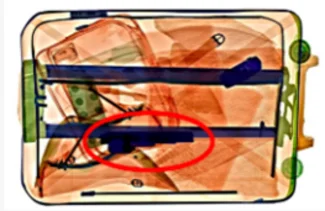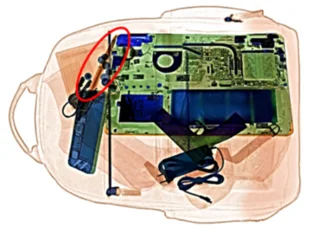The TSA X-Ray CBT test requires identifying specific items in X-ray scans within 15 seconds per question. Given the complexity of the images, strong skills are needed to pass. Successful candidates are more likely to be hired as Transportation Security Officers (TSOs).
Visit our TSA preparation page to access X-ray test questions mirroring the TSA exam, with specific tips and guidance on how to identify each of the items you'll be asked to identify.
What to Expect on the TSA X-Ray Test?
The TSA X-ray screening test (Object Recognition test) is used to assess your decision-making abilities and alertness.
In this TSA exam, you will be asked to identify specific items from X-ray images of luggage (which will be shown for only 10 seconds) and then state whether or not you saw them or not.
What Is the Format and Structure of the Test?
In the object recognition exam, you will be presented with changing x-ray images and will earn points only for correct answers, with no deductions for incorrect answers.
Each question asks you to locate a different item. That item may or may not appear, and you’ll need to answer by inserting a number in a box to indicate whether or not you believe the item is in the luggage.
Because the images change automatically, you should focus only on the current image and your current task.
If you are having trouble determining whether the item is in the luggage, be aware that you cannot go back and review the questions later. Each drill has a time limit, so completing all of them in time may be difficult.
What X-Ray Images Should You Expect on the Test?
There are popular items that will most likely appear in every X-Ray exam.
Guns

When doing the image interpretation test you will stumble upon many types, sizes, and colors of guns. The following characteristics can be identified by X-rays:
- Slide - The top of the gun contains the firing pin and the extractor. It is usually the densest part of the gun, so its color is usually the darkest.
- Trigger - A trigger is a device that opens a gun's firing mechanism. It may be hidden in some angles, while in other X-Ray scans it may become a distinctive feature.
- Grip - This is the part that is used to hold the gun. The grip includes a slot for the magazine. In the given picture you can see a magazine is inserted. Notice the spring, which is
a part of every magazine. You can see in the picture above that there is a zigzagged line inside the grip. That is the spring of the magazine.
Grenades
Among the grenade's most prominent features are the Lever and the Safety Pin. The body of the grenade is typically green or blue.
However, it is easier to identify it by the parts of the grenade rather than by color because these could vary and depend on the type of the x-ray machine used for the scanning.
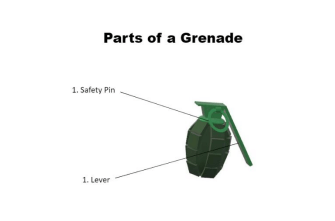
Knives
A variety of knives may appear on an x-ray scan image, from large knives to utility knives, sharp nail filers, and even scissors.
Specific designs that often show up on a scan include a commando knife that is identified by the metal screws that attach the blade to the handle, a Swiss knife, and a folding knife.
Other Items
X-ray sections can include other items, including pens, flashlights, smartphones, dolls, tools, and a variety of electronic devices.
Although the variety may seem confusing and hard to overcome, this is not something to be alarmed by. With enough preparation, you will be able to master the skill of scanning X-ray images.
Prior to the questions, every item in the exam will be shown in a preview that will allow you to familiarize yourself with the item's special traits.
Sample Questions
Question 4
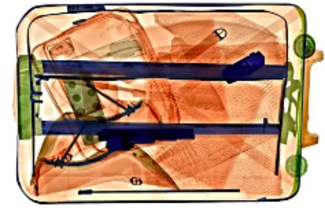
Scan this suitcase and decide whether:
Question 3
Can you identify a pen in this X-ray image?

Practice is Key to Success
Start practicing now with our PrepPack!
How to Read and Analyze an X-Ray Image on the TSA CBT Test?
In order to read and analyze X-ray images efficiently and quickly, it is crucial that you become familiar with the most common features of every item, it will help you find the correct answer.
The features are colors, chapes and angles, item position, and items that overlap one another.
Colors
When trying to read and analyze X-ray images it’s important to remember that the density of the scanned item determines the color of the X-ray images. When the material is denser, it appears darker.
Also, the color settings of different machines may differ, and although most items will appear the same way in different bags, they may appear differently in other bags.
Blue represents dense materials, such as metal, hard (dense) plastics, and different parts of weaponry. When the material is very dense, the blue may get darker to the point of black. Metal boxes or wires, for instance, will appear blue or black, or sometimes a mix of the two colors.
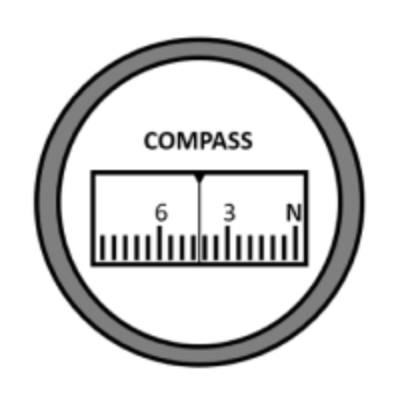
The Green color represents less dense materials such as plastics and alloys (less dense metals). Green indicates that a material contains less density than dense metals, but is denser than organic objects; green can be seen in stones, ceramics, plastic, and toys.

Orange is the least dense material, primarily biological. The color orange is assigned to all organic objects including wood, food, plants, animals, powders, rubber, and leather also sometimes plastic bottles are seen as orange.

Assault weapons: Although most guns, knives, and grenades are made of metal, their densities can differ, making them appear orange or green on X-Rays.
Shapes and Angles
Objects can be viewed from different angles or viewpoints. Some views, such as the front, are easy to identify, whereas others require much more effort.
The shape of the object can also make it difficult to spot, especially if you are not familiar with the objects on a regular basis in your daily life.
Objects Angle and Position
Items could be placed at odd angles that could make them impossible to recognize. The best way to deal with this problem is to have a list of all the popular items and get to know their different positions. Preparing in this manner will give you a major edge on the actual test.
Overlapping Items
Overlapping items can also be difficult to identify. To tackle the problem it's not enough to be familiar with the different items that can appear. You need to be aware of their different characteristics and features.
For example, as mentioned earlier a grenade includes two prominent features; the lever and the safety pin. The key is to look for these features when dealing with a scenario when an item is overlapped by another item.
What Makes the TSA X-Ray Test Difficult?
The main difficulty of the test is the limited amount of time you have to answer each question; you’ll only have 15 seconds to spot dangerous objects that may be laid in a strange position, come in an unfamiliar form, or overlapped by another item.
The test is hard and confusing enough without the time limit, adding it makes the whole task even more challenging because your success is now dependent on your ability to react quickly enough and find the correct solution fast.
Familiarity is the key to that; the more familiar you are with the different items and their unique characteristics the more likely it is that you’ll be able to identify them quickly before time runs out.
That's where a TSA CBT practice test can play a helpful role.
TSA Screening: The Next Step
The TSA test includes both an X-ray test and an English Test.
Once you pass the test, you will be invited to complete the TSA Airport Assessment.
Explore what's coming next and how to get prepared in JobTestPrep complete TSA Hiring Process guide.


